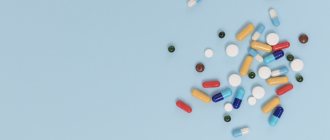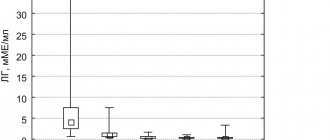© photo_gonzo — depositphotos.com
Share:
Aminalon is a medicine that has a nootropic effect, which is to improve metabolism, neuronal function and their blood circulation. The first drugs aimed at improving cognitive function and brain function in general were obtained in the last century, after which their effectiveness was tested in clinical studies using focus groups.
Many drugs turned out to be useless and had the same effect as a placebo. However, several drugs have proven effective, including Aminalon. The medicine is used in neurology, psychiatry and therapy due to its pronounced nootropic effect.
The drug is used in bodybuilding and sports due to its beneficial effect on the nervous system, as well as a moderate anabolic effect - the gamma-aminobutyric acid contained in the product promotes muscle growth and fat burning.
Mechanism of action
The main active ingredient of Aminalon is gamma-aminobutyric acid. The body synthesizes this substance in the subcortical regions of the brain. GABA is an inhibitory neurotransmitter of the central nervous system. By interacting with specific receptors, aminobutyric acid stops the transmission of impulses through synapses. This property of the drug is used as a component of complex therapy for Parkinson's disease, Alzheimer's disease, epilepsy of various origins, and sleep disorders.
© Zerbor — depositphotos.com. Structural formula of gamma-aminobutyric acid
In addition, gamma-aminobutyric acid is involved in many metabolic reactions of nervous tissue. Taking the drug allows you to improve blood supply to the brain and increase local trophicity of cells with oxygen. The medicine has a sedative effect, so it can be taken as a sedative. In some cases, the drug is prescribed for the treatment of hypertension as a component of antihypertensive therapy.
Gamma-aminobutyric acid does not have the ability to penetrate the blood-brain barrier. This feature explains the low therapeutic effect of the drug compared to anxiolytics and tranquilizers. However, a small portion may pass through protection through specialized transporter proteins.
Aminalon stimulates the release of somatotropin produced by the anterior pituitary gland. The hormone has an anabolic effect - it accelerates the process of muscle cell growth and regeneration in the event of microtrauma. Somatotropin also activates protein synthesis and accelerates the burning of fat from subcutaneous tissue. Thus, taking Aminalon is indirectly involved in building muscle mass and losing weight.
AMINALON (tablets)
These tablets are packaged in packs of one hundred and fifty tablets.
I was prescribed to take one tablet twice a day, so I decided to take a larger package. Here is a cardboard box with pills. The active ingredient of the drug Aminalon is gamma-aminobutyric acid. This is a non-essential amino acid. Lately I’ve been constantly receiving information on amino acids (I’ve already written about taurine and lysine). Based on its stated properties, gamma-aminobutyric acid seemed to me to be a very interesting drug: it has an anticonvulsant, sedative, and hypotensive effect. -improves memory, attention, thought processes; - normalizes sleep; -improves blood circulation in the brain. Fights oxygen starvation of the brain. It became clear why neurologists prescribe this drug for long-term use to patients suffering from a variety of vegetative-vascular disorders.
There is only one active ingredient in these tablets, and the only auxiliary ingredient is sugar. The box contains information about the manufacturer. These tablets are made in the city of Borisov, in Belarus. I trust Belarusian goods, including medical ones. I have also already bought medicine from this manufacturer.
The dosage in tablets of the active substance is 250 milligrams.
Later I discovered that Gamma-aminobutyric acid, although in the form of a dietary supplement, is available in the Eicher online store. Moreover, gamma-aminobutyric acid is available in much larger dosages, with a single dose per day and from a variety of manufacturers. I'll probably buy there next time.
There are ten blisters of ten tablets in a box. The tablets are small and white. Unlike Mexiprim, these tablets do not smell like anything. They also have no taste, although I didn’t bite into them. Easy and simple to drink. The stomach did not react to them in any way, or rather, I took this medicine completely normally.
Convenient packaging, you can carry it with you in your purse.
Since in this case I have a medical drug, detailed instructions are attached to it, as expected. Here I photographed it as best I could.
My stomach didn’t react, but I drank it for my head. And the head reacted, and noticeably. When I took these pills, my head was clearer, there was less reaction to weather changes, especially to winter thaws. My mood was noticeably better, although this is a nootropic drug, it does not have any psychotropic effects. It was also important for me to improve my sleep; for some reason in the winter I have problems sleeping. I’ll say right away that these pills do not cause drowsiness. And when taken at night, they do not work as a sleeping pill. But I accidentally discovered through experience how to improve sleep with the help of aminalon. In general, to improve my sleep, I ordered Melatonin, which I have known for a long time, from Iherb (here is a review about it). And one might say I was almost disappointed in him. Well, a very weak effect. At my own risk, I took two tablets, although this is not good. And then one evening I took a Melatonin tablet and an Aminalon tablet almost simultaneously. And I ended up sleeping great. I tried again. Works! I removed Aminalon - not the same. That is, in a pair Aminalon (or perhaps any other drug with gamma-aminobutyric acid) and Melatonin improve sleep very well. Moreover, in the morning my head is clear, there is no weakness that occurs from sleeping pills.
So, after taking a course of Aminalon twice a day, now sometimes in the evening I drink Aminalon and Melatonin for better sleep. But this is just my personal experience, although I think that there is nothing harmful in this combination.
I bought these pills at a regular pharmacy, no one asked for the recipe, which means they will sell them without a prescription. The price in my opinion is quite affordable. I bought one hundred tablets for 192 rubles. This is almost enough for two courses of treatment, and if you take a tablet at night, then it will generally last for a very, very long time.
In total, according to my intake of these pills, I will note. Pros: - the active ingredient is very necessary for the brain. Its deficiency is immediately noticeable. I found information about conditions associated with GABA deficiency and everything coincided. — the tablets improved the condition of the head, gave clarity, practically relieved dizziness, improved mood, and had a noticeable calming effect. - help normalize sleep. — there is no state of inhibition, rather, on the contrary, they increase performance. - there were no side effects at all.
I don’t suffer from increased blood pressure, so I can’t say anything in this direction. But I admit that these pills normalize blood pressure to some extent. In general, the action of Aminalon somehow reminded me of Glycine, only in a stronger version. But one Glycine tablet hasn’t helped me for a hundred years; I take at least five at a time. So, one Aminalon tablet works like five glycine tablets. By the way, we need to compare these acids somehow.
But there are also disadvantages: - the effect lasted while I took these pills and for a very short time after finishing taking them. And then everything returned to normal - dizziness and other vascular problems. That is, I did not notice a significant cumulative effect. And in general, these tablets can probably be regarded more as vitamins for the brain, although in this case they are a drug.
But due to the noticeable positive effect, if these tablets were prescribed to you by a competent doctor or you yourself, after analyzing your condition, found the symptoms to be a deficiency of gamma-aminobutyric acid, then of course I recommend it. In general, it seems to me that GABA will not be superfluous to anyone.
Health and optimism to everyone! Thank you for your attention!
Indications
Indications for taking Aminalon are:
- atherosclerotic damage to the cerebral arteries - while taking the drug, the blood supply to the nervous tissue and the functioning of neurons improves;
- complications resulting from a traumatic brain injury;
- Alzheimer's disease - Aminalon moderately improves oxygen saturation of the brain, slows down the process of degradation of nervous tissue, improves memory and other cognitive functions;
- Parkinson's disease as a sedative;
- insomnia;
- frequent headaches;
- mental illnesses that are accompanied by a decrease in intelligence;
- polyneuropathy of alcoholic or diabetic origin;
- consequences of cerebral stroke;
- arterial hypertension.
The use of Aminalon benefits athletes - the medicine induces the production of growth hormone, has a sedative effect, and corrects sleep disturbances.
The use of aminalon to improve intellectual and mnestic function[edit | edit code]
Aminalon
(gammalon)—Aminalonum, gamma-a minobutyric acid; synonyms: apogamma, GABA, gaballon, gamavex, gammalon, gammar, gammasol, ganevrin (PNR), myelogen, milomad.
Chemical formula
: NH2—CH2—CHg—CH2—COOH.
Empirical formula
: C4H9O2.
Gammalon
- white crystalline powder, slightly bitter in taste. Melting point - 202-204°C. It is highly soluble in water, slightly soluble in alcohol when heated, and insoluble in organic solvents.
Being a biogenic substance, it participates in metabolic processes of central inhibition in the central nervous system, enhances energy processes, utilization of glucose by the brain, increases the respiratory activity of brain tissue, improves blood supply, and promotes the removal of metabolic products from the brain (I. A. Sytinsky, 1977; A. N. Gurlenya, V. I. Talapin, 1978; K. S. Raevsky, V. P. Georgiev, 1986). Gammalon increases the formation of acetylcholine in the brain.
Aminalon (gammalon) is produced in tablets (0.25 g) with a sugar coating, as well as for injection - 5% 20 ml in ampoules or 20% 100 and 500 ml in bottles for internal use. It is administered orally at a dose of 0.5-1.0 g 3 times a day, the course of treatment is from 2-3 weeks to 2-4 months. Gammalon for injection is used only for intravenous drip administration.
The main indications for the use of gammalon are cerebrovascular insufficiency associated with aging, brain injury, hemorrhage, and atherosclerosis. Gammalon eliminates or alleviates various mental or somatic disorders, such as memory loss, speech impairment, aphasia, paralysis, resulting from cerebrovascular disorders.
Aminalon is effective in the treatment of patients with ischemic stroke: general cerebral symptoms and focal neuralgic disorders disappear faster. High blood pressure decreases and stabilizes in patients with decompensation of chronic cerebrovascular insufficiency, signs of encephalopathy decrease: the emotional sphere was normalized, behavior was streamlined, the phenomena of mental exhaustion decreased, memory improved (L. S. Petelin et al., 1971; N. N. Anosov, B. S. Vilensky, 1978). The effect of gammalon treatment appears 2-3 weeks after taking 4-5 tablets 3 times a day or 5 ml of a 20% solution 3 times a day.
Gammalon (aminalon) helps improve subjective symptoms: relieves headaches, tinnitus, dizziness and others resulting from skull trauma.
Gammalon is effective in the treatment of mentally retarded children. Treatment with gammalon increases the activity, sociability of children, their IQ, and school performance. The effect of treatment begins to appear after 2-3 weeks, but it takes 2-4 to get the full effect. month. It is recommended to give the drug to children aged 1-3 years, 4-8 tablets or 5-10 ml of a 20% solution per day; children aged 4-6 years - 8-12 tablets or 10-15 ml of 20% solution per day.
Gammalon causes a gradual decrease in blood pressure, bringing it to normal levels (in persons over 40 years of age, the maximum pressure does not drop below 140 mm Hg). Dizziness, insomnia, etc. are alleviated or reduced. Gammalon is prescribed for hypertension, 4-5 tablets or 5 ml of a 20% solution 3 times a day. The effect occurs within 1-7 days.
The neurometabolic effects of gammalon allow it to be used as a means of awakening from stupor caused by anesthesia, hypnotics, carbon monoxide poisoning or other similar gases, uremia, as well as from stupor due to damage to cerebral blood vessels and hepatic stupor. Gammalon for stupor is prescribed intravenously by drip over 2-3 hours: 15-20 ml of a 5% solution in 300-500 ml of saline for injection. The effect occurs 3-20 hours after administration of the drug.
Indications for the use of gammalon are as follows:
(A. M. Gurlenya, V. I. Talapin, 1978):
- cerebral atherosclerosis;
- hypertonic disease;
- chronic cerebrovascular insufficiency with impairments of memory, attention, speech, headache, dizziness;
- dynamic disturbance of previous cerebrovascular accidents with the presence of paresis, paralysis, traumatic brain injury;
- alcoholic encephalopathy;
- polyneuritis;
- oligophrenia;
- cerebral palsy;
- endogenous depression;
- astheno-hypochondriacal manifestations.
Side effects when taking aminalon include vomiting, sleep disturbance, feeling hot, and fluctuations in blood pressure.
No contraindications have been established.
Contraindications
The drug is contraindicated in case of an allergic reaction or individual intolerance. It is also not recommended to use the product for decompensated heart and kidney diseases.
Diabetes mellitus is a contraindication to the use of the medication. People with this pathology should consult an endocrinologist before using the drug. The medicine promotes the production of somatotropin, which is a counter-insular hormone that increases blood glucose levels.
Method of administration of the medicine and dosage
Aminalon is recommended to be consumed 30 minutes before meals. In this case, you should take the medicine with plenty of water.
Typically, two tablets are prescribed per day, with the first dose being small to prevent fluctuations in blood pressure. Gradually the concentration of the product increases to the required values over several days.
The course depends on individual characteristics, the presence of somatic diseases, their nature and characteristics of the course. On average, the duration of therapy with Aminalon is one month.
The greatest effect is recorded in the second week of taking the medication, since gamma-aminobutyric acid has a cumulative property, small concentrations do not cause the necessary effect.
Athletes should take the medicine immediately after training, as well as in the interval between physical activity. The maximum permissible dosage is 3 g per day.
The use of aminalon in psychiatry and narcology[edit | edit code]
Aminalon was one of the first nootropic-like drugs in the world to be introduced into the practice of treating mental patients. To date, despite a fairly wide range of indications for use, the main area of its use is various manifestations of cerebral pathology in the form of cerebrasthenic and encephalopathic disorders of various etiologies, both with persistent and dynamic disorders of cerebral circulation, with organic lesions of the central nervous system, mental backwardness, etc. (G. Ya. Avrutsky et al., 1981).
The most severe and persistent condition, developing, as a rule, at distant stages of organic damage to the central nervous system, is the impoverishment of all mental activity - dementia.
Due to the difficulties in treating this pathology, the treatment of dementia is of particular importance.
M. M. Saarma et al. (1983) report on the experience of using aminalon in patients with organic dementia. The drug was prescribed for 6 weeks to 17 patients with organic dementia of traumatic and atherosclerotic origin and patients with senile dementia. The effect of aminalon, used in doses of 1.5 g per day, was compared with the results obtained when using placebo in 25 patients. Along with the clinical assessment of the patients’ condition, determined using unified scale methods, the authors purposefully examined the dynamics of memory and intellectual abilities, using six experimental psychological tests for this purpose.
At the end of the 6-week course of treatment, M. M. Saarma et al. noted an improvement in the condition of patients taking aminalon in 48% of cases. In approximately half of the patients taking the study drug (47% of cases), the condition remained unchanged and in 5% of cases there was a deterioration in the condition. In the group of patients receiving placebo, a positive effect was noted only in 8% of cases. Thus, data on improvement in the condition of almost half of patients with dementia certainly indicate the possibility of using aminalon in the treatment of dementia caused by organic and atrophic brain damage.
When analyzing data from experimental psychological tests, it was found that in the group of patients receiving placebo, there was a deterioration in various indicators of memory and thinking function. Patients taking aminalon showed an improvement in efficiency in both memory functions and intellectual activity. However, the ability to acquire and assimilate new material, as well as the general intellectual level of the patients, did not change.
The most interesting is the report of the same researchers (M. M. Saarma et al., 1984) on a comparative clinical and psychological study of aminalon, glutamic acid, piracetam and placebo in 90 patients with organic dementia of various origins. The authors, as in the previous study, do not provide characteristics of the clinical types of dementia. Evaluation of the psychotropic activity of drugs is limited to observations of their effect on intellectual-mnestic disorders.
The studied drugs, according to the severity of the clinical effect, were arranged in the following order (from weak to strong): placebo, glutamic acid, aminalone, piracetam. A noticeable improvement was noted with their use in 0%, 8%, 24% and 44% of cases, respectively.
Based on the available material, the authors concluded “that in cases of deep dementia, no particular improvement in intelligence and memory functions can be expected from the use of nootropic drugs.” In their opinion, it is advisable to include nootropic drugs in the treatment system for milder forms of dementia. This point of view is shared by G. P. Panteleeva et al. (1975), who noted the complete absence of the therapeutic effect of aminalon in 11 patients with severe atrophic (6 people) and traumatic (1 person) dementia and severe psychoorganic syndrome persistent for 20 years or more (4 people). In these patients, resistant to other types of therapy, the phenomena of deep amnestic dementia with confabulatory disorders were observed. Aminalon therapy was carried out in doses of up to 2.25 g per day for a long time (up to 3 months).
R. G. Golodets et al. (1976), R. A. Altshuler et al. (1975), G. P. Panteleeva et al. (1975) present the results of successful treatment of patients with organic diseases of the central nervous system with aminalon. Thus, G. P. Panteleeva et al. (1975) note that in a group of patients with organic brain diseases (47 people) of vascular, traumatic and atrophic origin, improvement was noted in 38 patients. Significant improvement in condition occurred in 21 patients with psychoorganic syndrome of vascular (atherosclerosis, hypertension) and traumatic origin. In these cases, we were talking about patients with a relatively short duration of the disease (no more than 3-6 years). Before treatment with aminalon, they experienced increased irritability, tearfulness, memory impairment, rapid fatigue and exhaustion, as well as headaches, dizziness, noise in the head, impaired depth and duration of sleep. In some cases, there was brutality, conflict, mood disorder with a feeling of dissatisfaction with others and with one’s own well-being, pickiness or, on the contrary, apathy and lethargy.
Aminalon in doses of 0.75-1.0 g per day caused an improvement in general health after 1.5-2 weeks. Patients expressed a positive attitude towards treatment, there was a subjective feeling of calm and a decrease in irritability. Headaches, dizziness, noise in the head and other unpleasant symptoms decreased and then disappeared.
At 2-3 weeks of treatment, normalization of blood pressure was observed. Objectively, the patients became noticeably calmer in their communication, their sleep normalized, their mood leveled out, they became more active, took an interest in their surroundings, began to take care of their appearance, and showed initiative in working within the department.
At 3-4 weeks of treatment, the symptoms of weakness disappeared or significantly decreased, and the ability to remember slightly improved (patients more accurately named individual dates from the past and present). Memory disorders subjectively bothered the patients less, although complete restoration of mnestic functions was not observed.
Significant improvement was noted in 2 patients with a state of acute confusion of vascular origin. The addition of aminalon to previously prescribed treatment led to a relatively rapid recovery from the psychotic state within 1.5-2 weeks with a critical attitude towards painful disorders and without subsequent signs of severe dementia.
In 13 patients with symptoms of psychoorganic syndrome and atrophic dementia, one could speak of a slight improvement in condition. During 2-3 months of therapy with aminalon, they experienced only a slight decrease in irritability, some improvement in well-being, and an increase in activity. Memory impairments, however, did not show reverse dynamics. The disease in these patients lasted a long time (20-30 years), and the condition was determined by persistent symptoms of organic personality changes, which in 2 cases had signs of secondary atrophy.
Thus, according to G.P. Panteleeva et al., the absence of an effect or its slight improvement in organic diseases was noted in patients either with a long history of the disease or with significant negative manifestations and dementia. A noticeable improvement during treatment with aminalon occurred in patients with a relatively short duration of the disease, no more than 10 years, mostly from several months to 5 years. In these cases, there were no gross personality changes or signs of dementia, and the pathological changes were largely functional in nature.
R. G. Golodets et al. (1976) studied gammalon (a Japanese analogue of aminalon) both in the acute phase of organic damage to the central nervous system (especially in neuroinfections and neurointoxications) and in the residual stages of the disease.
Their publication provides an analysis of the results of treatment with gammalon in 70 patients. The main indications for prescribing the drug were asthenic symptoms, persistent or transient disorders of mnestic functions (antero- and retrograde amnesia, disturbances of fixation memory and other dysmnestic manifestations), as well as a general decrease in intellectual productivity (in the form of disturbances in attention processes, tempo of thinking, weakness of impulses) .
Daily doses of the drug did not exceed 2.75 g. Treatment continued in courses of 2-4 months, less often up to six months.
At more distant stages of organic lesions of the central nervous system, the effect of gammalon was manifested in a noticeable increase in activity, a decrease and then disappearance of manifestations of physical and mental asthenia, and an improvement in mnestic-intellectual functions.
In a number of cases, there was a more noticeable restoration of memory impairment for past events and a general increase in intellectual productivity.
According to R. A. Altshuler et al. (1975), the use of aminalon is also effective in the early post-traumatic period. The use of the drug in these conditions promotes a more rapid and complete restoration of brain function.
Available literature data indicate the possibility of using aminalon as a means of potentiating the effect of psychotropic drugs. According to G.P. Panteleeva et al. (1975), out of 28 patients with manic-depressive psychosis and schizophrenia with treatment-resistant conditions, improvement after using aminalon was noted in 21 patients. A particularly good effect was recorded in 15 patients with mild depression within the framework of these diseases with a duration from several months to 5 years. The condition of these patients before the appointment of aminalon was determined by depression with a variety of senesto-hypochondriacal disorders and complaints of difficulties in mental activity, “inhibition,” a feeling of “staleness” in the head, difficulties in learning what to read, and fatigue. As already mentioned, despite various (up to several months) psychopharmacotherapy, there was no improvement in their condition.
With the addition of aminalon to the treatment (up to 2.5-3 g per day), on the 3-5th day the patients became more active, their facial expressions became more animated, and they began to participate in collective events. By the end of the first week of treatment, patients had a subjective feeling of cheerfulness, “freshness” in the head, and they had fewer hypochondriacal complaints. Then their painful, vague headaches disappeared, and their sleep improved. Subsequently, with a subjective feeling of improved well-being, patients noted a gradual disappearance of their previously characteristic fatigue and depression, and an improvement in mood was noted.
In 3 patients, after 1 month of treatment with aminalon, a transition to a hypomanic state was noted.
A significant improvement in well-being with increased activity was noted in 2 patients out of 8 patients with long-term depression with motor inhibition or hallucinatory-delusional disorders (hypochondriacal delusions, ideas of relationship or persecution). In the remaining 6 cases, in patients with similar depressive syndromes, as well as apathetic dementia, there was only a slight therapeutic effect when using aminalon.
A positive therapeutic effect was also not observed in 7 patients with conditions syndromologically similar to the disorders described above (flaccid depression, depression with obsessions, apathetic dementia). In these patients, negative disorders also occupied a significant place in the clinical picture, and the duration of the disease exceeded 20 years.
The results obtained quite accurately determine the criteria for the effectiveness of aminalon in the treatment (as an adjuvant) of protracted depressive states - the relative “simplicity” of depression, the absence or insignificant severity of negative symptoms in the structure of the condition, the short duration of the disease.
Of greatest interest are comparative studies of a number of drugs.
V. E. Vasar (1987) studied the characteristics of the psychotropic action and clinical effectiveness of aminalon in comparison with piracetam, phenibut and diazepam in 196 patients with neuroses and somatogenic neurosis-like conditions.
Aminalon did not differ from piracetam in its effect on individual symptoms. According to the author, aminalon was inferior to phenibut and piracetam in its effect on phobic-asthenic, depressive-asthenic, hypochondriacal-asthenic symptoms. In terms of the speed of manifestation of the therapeutic effect, aminalon also took last place after diazepam, phenibut, and piracetam.
V. E. Vasar comes to the conclusion that “aminalon is indicated in the treatment of patients with neurosis-like conditions caused by vascular diseases of the brain. When treating patients with other types of neurosis-like conditions and neuroses, aminalon is less effective than piracetam and phenibut.
The above applies to the analysis of the effectiveness of aminalon when used monotherapeutically. In our opinion (taking into account existing publications), complex therapy combining aminalon with other psychotropic drugs used for the condition has a much greater impact on improving the symptoms of patients and makes it possible to give broader recommendations for the use of aminalon for borderline disorders.
The literature also contains indications of other aspects of the use of aminalon or its analogues for the treatment of children with mental retardation (W. Shibata et al., 1960), the treatment of paroxysmal disorders (D. de Maio, 1962; T. Hayashi et al., 1965) .
I. A. Sytinsky (1971), in one of the first reviews on the clinical use of aminobutyric acid derivatives, reports that, according to W. Shibata et al. (1960), with various forms of mental underdevelopment, in 63 cases out of 106 children showed an improvement in their condition.
Japanese researchers T. Hayashi et al. (1965) found that taking the drug in doses of 0.3-0.8 g per day completely eliminates seizures in 38% of patients with epilepsy, and the effect after discontinuation of the drug persists for 6 weeks. According to other data, treatment is effective in 56.7% of cases (with fluctuations from 35 to 83% depending on the severity and nature of convulsive manifestations) (D. de Maio, 1962).
Italian researchers (V. Floris et al., 1962) believe that the greatest effect of the drug is manifested in petit mal.
It should be said that in recent years the number of publications on the use of aminalon and its analogues in child psychiatry and in the epilepsy clinic is a small part in comparison with the literature data on the use of other nootropic and nootropic-like drugs for these indications. In all likelihood, this can be explained by the fact that clinicians have established greater effectiveness and safety of the use of modern nootropic drugs than aminalon. We have not found any publications on comparative clinical studies of existing nootropic drugs (including aminalon) for these indications in the literature.
Side effects
In case of an allergy to the drug, rhinitis, conjunctivitis, and skin rashes of various locations may occur. Also, with increased sensitivity to the components of the drug, abdominal pain, nausea, vomiting develops, and loose stools are replaced by constipation. If such symptoms appear, the drug should be discontinued. Regular use of the medication in rare cases causes sleep disturbances and a rise in body temperature.
The most common side effect is a change in blood pressure from low to high values. The pathology is accompanied by headache, and orthostatic hypotension may appear.
Precautions and special instructions for use
Due to the fact that Aminalon can change blood pressure, the first dose of the drug is recommended to be taken under the supervision of a doctor. In the presence of hypertension and other heart diseases, lower doses of the drug may be prescribed.
It is recommended to use the medication during the daytime, otherwise insomnia may occur.
You cannot combine alcohol and Aminalon. Their interaction leads to neutralization of the therapeutic effect of the drug and increased severity of side effects.
Clinical studies have not proven the effect of Aminalon on reaction and concentration, so you can drive a car while taking it.
The medicine is sold in pharmacies without a prescription. Before using the medicine, you should consult your doctor.
Analogs
Amylonosar is a medicine based on nicotinoyl-gamma-aminobutyric acid. The medication belongs to the group of nootropic drugs. Improves cerebral circulation, oxygen saturation of nervous tissue, exhibits moderate antiplatelet activity, which is used in the treatment of coronary heart disease and other pathologies.
Long-term use of the drug reduces the severity of amnestic syndrome and has a hypnotic and sedative effect.
Phezam is a drug that contains piracetam and cinnarizine. This combination effectively increases blood flow in the brain, improves memory, speech, and mental activity. By influencing the rheological properties of blood, it reduces its viscosity, which prevents or reduces the risk of thrombosis.
The medicine is prescribed for atherosclerosis of the cerebral arteries, frequent headaches, mental disorders, organic lesions of the central nervous system. In addition, the drug has an effect on the vestibular apparatus - it reduces its excitability. This property is used to treat various labyrinthopathy.
Noofen contains aminophenylbutyric acid. The drug has a pronounced neuroregulatory effect. Noofen improves memory and mental activity, increases learning ability, endurance, productivity and ability to work.
While taking the medication, sleep is restored and the symptoms of anxiety syndrome are relieved.
Effective use for emotional instability and mental disorders. In neurology it is used to partially relieve or completely eliminate nystagmus.
The use of aminalon in neuropathology[edit | edit code]
Aminalon is gamma-aminobutyric acid (GABA), in its final effect it is close to nootropics. It changes the functional activity of the brain, is formed in the body from glutamic acid, and is a mediator of inhibitory processes. With conventional methods of administration, it penetrates poorly through the BBB.
The ability to dilate blood vessels appears to be due to its action on specific vascular receptors (including receptors in the cerebral arteries).
When the BBB is disrupted, when GABA penetrates better into the brain, its central inhibitory effect cannot be excluded. Inhibition of brain functional activity increases tolerance to hypoxia.
Under the influence of GABA, the respiratory activity of brain tissue increases, glucose utilization improves, blood supply improves, and the removal of metabolic products from the brain is accelerated (I. A. Sytinsky, 1977).
The action of GABA in the central nervous system is carried out through interaction with GABAergic receptors, which are in close connection with dopaminergic and other receptors in the brain.
In recent years, a subunit of the protein nature of the GABA receptor, the so-called GABA modulin, has been isolated, which regulates the binding and affinity of the receptor to the mediator, GABA.
As a medicine, aminalone is obtained synthetically. Indications for the clinical use of aminalon are mainly vascular diseases of the brain.
Taking GABA improves the dynamics of nervous processes, improves thinking, memory, and has a mild stimulating effect. Promotes the restoration of movements and speech, reduces vestibular disorders in patients with cerebrovascular accidents and after brain injuries.
Aminalon is prescribed both after transient cerebrovascular accidents, and after strokes and in chronic cerebrovascular insufficiency (CVI) in order to increase the motor and mental activity of patients. In children they are used for mental retardation (L. S. Petelin et al., 1971; N. S. Sazonova, E. G. Balashova, 1974; F. A. Poemny, B. M. Trubnikov, 1975; L. G. Stolyarova et al., 1972; L. G. Garkusha et al., 1978).
A clinical study of the action of aminalon (gammalon) was carried out on a large material by L. S. Petelin et al. (1971). The authors note that during acute cerebrovascular accidents (ACVA) in ischemic patients, both general cerebral and focal symptoms passed faster. With intravenous drip administration of 20 ml of a 5% solution of 10 g per 500 ml of isotonic sodium chloride solution, the effect was higher than when taking the drug orally up to 12 tablets of 0.25 g each (i.e. 3 g of the drug).
In case of CVVN, blood pressure stabilized (while it increased), normalization of the emotional sphere, behavior, and mental exhaustion was noted—memory improved. Duration of treatment is up to 2 months. The effect lasted 6-8 months,
N. N. Anosov, B. S. Vilensky (1978) note the high effectiveness of gammalon in the acute stage of ischemic stroke, but only with intravenous drip administration.
The authors point out the replacement nature of therapy for GABA, which is normally found in the brain.
The ambiguity of ideas about the action of aminalon is expressed in the fact that M. D. Mashkovsky and co-authors, back in 1974, mentioned GABA as a mediator of inhibition, and other authors note its stimulating effect on cerebral metabolism and antispasmodic effect (L. S. Petelin, L I. Goldenberg, 1971; N. S. Sazonova, E. G. Balashova, 1974; F. A. Poemny, B. M. Trubnikov, 1975; L. G. Stolyarova et al., 1972; L. G. Garkusha et al., 1978; L. S. Petelin et al., 1971).
L. S. Petelin and L. I. Goldenberg (1971) observed a faster and more significant restoration of function in 64% of patients than without prescribing aminalon.
In 30% of the total number of patients treated with GABA, an “awakening” effect is observed - a rapid exit from the soporous state.
Similar data are shown by N. N. Anosov and B. S. Vilensky (1978): in 24 out of 40 comatose and stuporous patients, by the end of the drug infusion, the degree of depression of consciousness decreased, followed by a rapid regression of neurological symptoms. A less pronounced effect occurred in 12 patients, 4 died. With high blood pressure, a noticeable decrease was noted.
L. S. Petelin, V. A. Pigarev (1971) indicate that when gammalon is taken orally in a double-blind manner, even the maximum doses give an insignificant clinical effect. The same is confirmed by N.N. Anosov and B.S. Vilensky (1978) on 45 observations and D.A. Markov et al. (1973).
N. N. Anosov and B. S. Vilensky (1978) believe that since gammalon in the body is converted into succinic acid and is included in the Krebs cycle, which is accompanied by the release of a significant amount of energy, the second mechanism is more likely and significant -1 activation of energy processes ( normalization of glycolysis, increased absorption of glutamic acid, neutralization of ammonia).
It is indicated that gammalon, acting as a mediator on a number of links in adrenergic and cholinergic structures, corrects the action of neurons that activate the reticular formation, and also promotes moderate vasodilation, increased cerebral blood flow, and increased oxygen consumption in the brain.
This position is confirmed by the peculiar “awakening” effect of gammalon. When it is early in its course, it is possible to quickly remove the patient from the soporous, and sometimes from the comatose state of patients with strokes, as well as victims of various poisonings.
The rate of administration is 25 -35 drops and 1 minute. With faster administration, collapse develops (and even more so with jet injection).
Can be administered intravenously 2 times a day for 3-4 days. When prescribing 3 - 4 tablets per day (N. N. Anosov, V. S. Vilensky and many others), side effects were noted - insomnia, motor restlessness.
In our observations, we also noted insomnia, sometimes increased blood pressure, and increased sexual excitability at maximum doses (0.25 g x 0-8 times a day).








